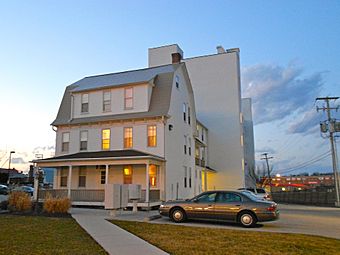West Side Sanitarium facts for kids
Quick facts for kids |
|
|
West Side Sanitarium
|
|

West Side Sanitarium in February, 2012
|
|
| Location | 1253-1261 West Market St., West York, Pennsylvania |
|---|---|
| Area | 1.5 acres (0.61 ha) |
| Architect | Leber, Edward |
| Architectural style | Dutch Colonial Revival, Queen Anne |
| NRHP reference No. | 04000400 |
| Added to NRHP | May 5, 2004 |
The West Side Sanitarium, also known as West Side Osteopathic Hospital, is a group of old buildings in West York, Pennsylvania. These buildings once served as a special hospital called a sanitarium. A sanitarium is a place where people go to get better from illnesses, often for a long time.
This complex includes four main buildings. There are two large buildings that were used for medical care. The other two buildings were homes for doctors and nurses.
Contents
History of the Sanitarium Buildings
The main building of the West Side Sanitarium was first built in 1905. It started out as a hotel! Later, in 1924, it got much bigger. A new section was added, making the building twice its original size.
Building Styles and Features
The main sanitarium building has a special look called Dutch Colonial Revival style. It is made of brick and wood. It has a unique roof shape called a gambrel roof, which looks like a barn roof. This building is about 110 feet wide and 31 feet deep.
Nurses' Home and Annex
The Nurses' Home and Sanitarium Annex was built in 1924. It also has the Dutch Colonial Revival style. This building was expanded in 1931 with a tall, four-story addition. It has a porch across the front with classic Tuscan order columns.
Doctors' Homes
The Doctors' Home and Dr. Meisenhelder's Home and Office were built in 1905. These homes have a style called Queen Anne. They are two and a half stories tall. Their roofs are covered with slate and have a cross-gabled shape. Each of these homes is about 20 feet wide and 40 feet deep.
Underground Connections
An interesting fact about these buildings is that three of the four are connected! They have tunnels that link them together underground.
What Happened Next
The hospital operated until 1962. After it closed, the buildings were used for other purposes. First, they became a business college. Later, they were home to the Aquarian Church of Universal Service.
A Historic Landmark
Because of its history and unique architecture, the West Side Sanitarium was added to the National Register of Historic Places in 2004. This means it is recognized as an important historical site.



